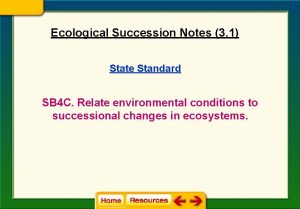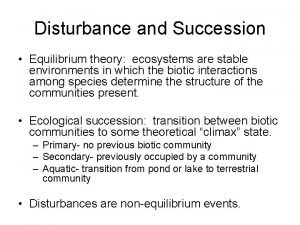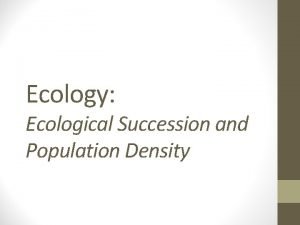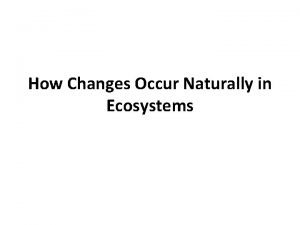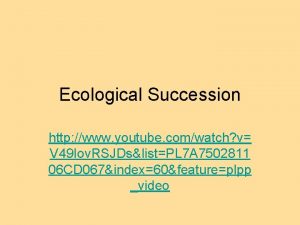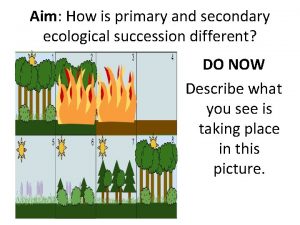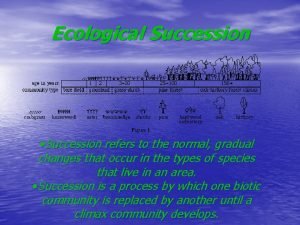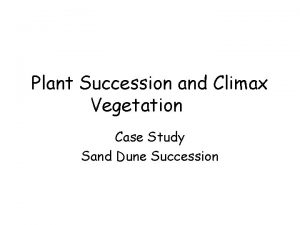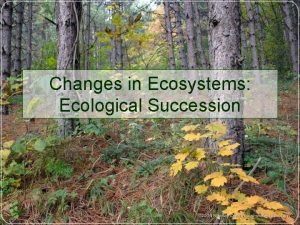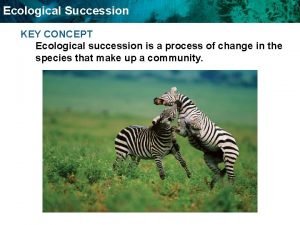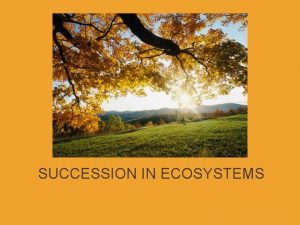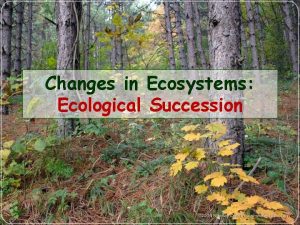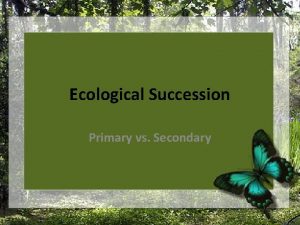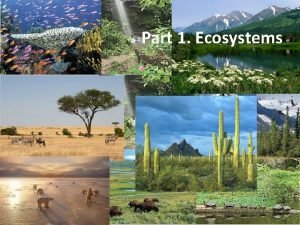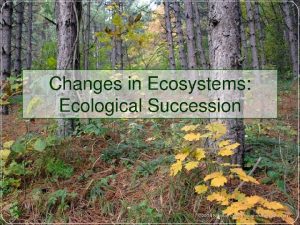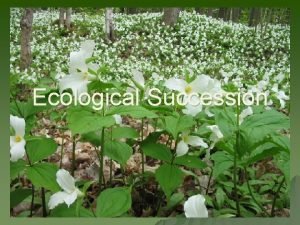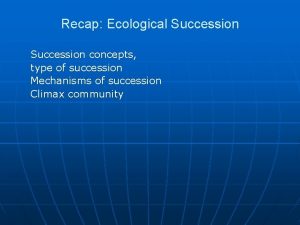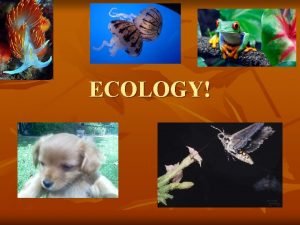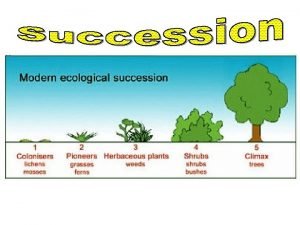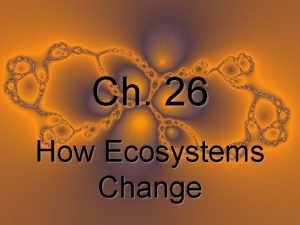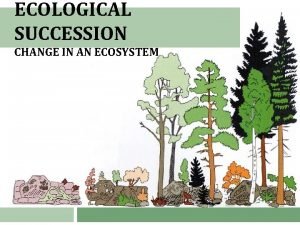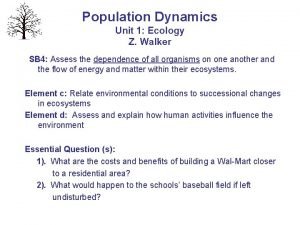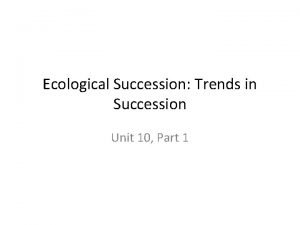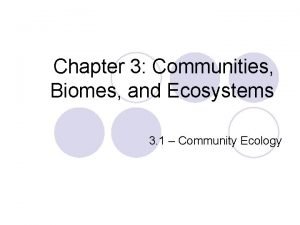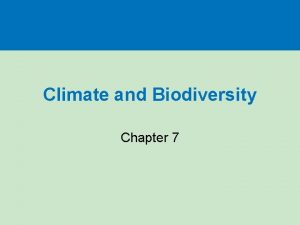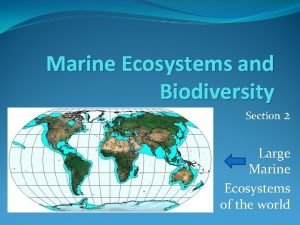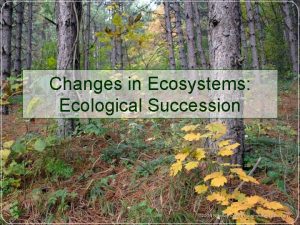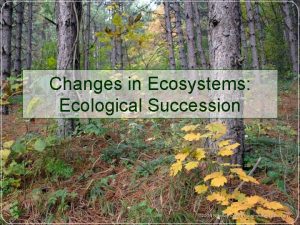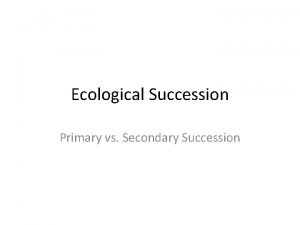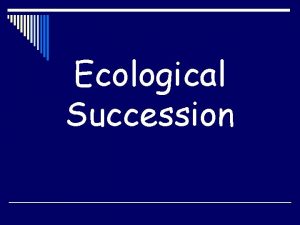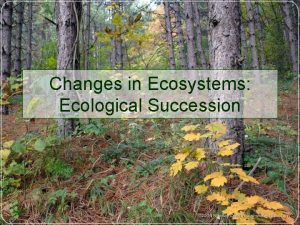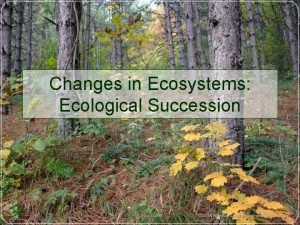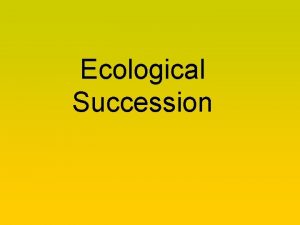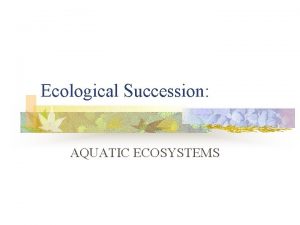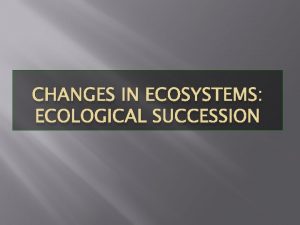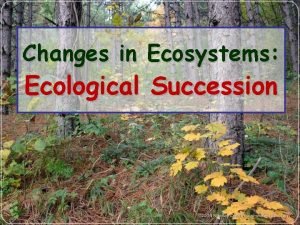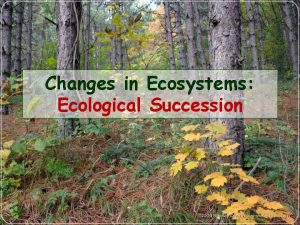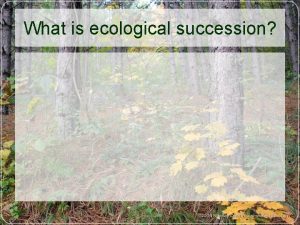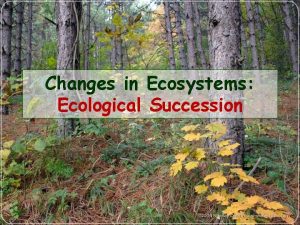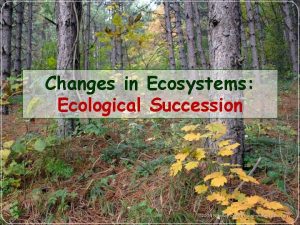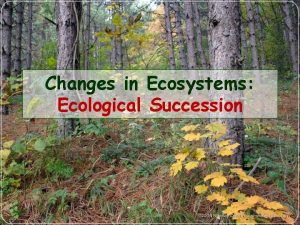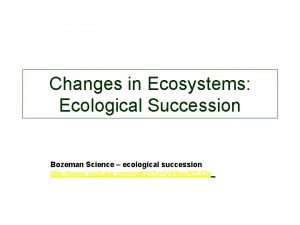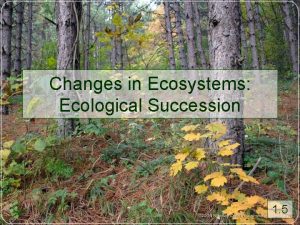Changes in Ecosystems Ecological Succession Ecological Succession Natural




































- Slides: 36

Changes in Ecosystems: Ecological Succession

Ecological Succession: • Natural, gradual changes in the types of species that live in an area; • The gradual replacement of one plant community by another through natural processes over time

Two Types of Succession • can be primary or secondary – Primary succession: formation of a brand new ecosystem. – Secondary succession: recovery of an old ecosystem.

Primary Succession • Primary succession occurs when a community forms in an area that has not been previously occupied – Ex. Exposed rock, lava, melted ice, eroded sand – Begins in a place without any soil • Occurs over a LONG period of time

Primary Succession • due to events such as: – Volcanoes – Glaciers – Asteroids

Primary Succession • Occurs in a series of regular stages • Lichens arrive first because they do not need soil to survive • They are called the pioneer species

Primary Succession • Soil starts to form as lichens and the forces of weathering and erosion help break down rocks into smaller pieces • When lichens die, they decompose, adding small amounts of organic matter to the rock to make soil.

• Once enough soil has been generated to retain nutrients, small plants, flowers, ferns, and shrubs can begin to grow.

Primary Succession • Simple plants like mosses and ferns can grow in the new soil

Primary Succession: Intermediate Stages • The simple plants die, adding more organic material to the soil. • The soil layer thickens, and grasses, wildflowers, and other plants begin to take over

Primary Succession: Intermediate Stages • These plants die, and they add more nutrients to the soil • These plants can further break down the rock, allowing more soil to be formed and retained. • Shrubs and trees can survive now

Primary Succession: End Stages • As the shrubs and trees mature, insects, small birds, and mammals move in • What was once bare rock now supports a variety of life

End Stages = Climax Community • Eventually, a mature community results, in which there is little change in the composition of species. • Climax Community = a mature and stable community of plants and animals • This is reached towards the END of succession!! • dominated by more-tolerant species • general equilibrium reached • long-term presence if not disturbed

Secondary Succession • Secondary succession occurs in an area that was previously occupied by living organisms, but the community was destroyed by a disturbance. – Ex. Fire, farming, hurricane, etc. • Begins in a place that already has soil and was once the home of living organisms

Secondary Succession • Established community is destroyed but soil is still intact therefore it takes less time than primary succession • Process typically begins with weeds and grasses (pioneer species) that are able to grow quickly

Pioneer Species

Tolerant vs. Intolerant Plant Species

Tolerant vs. Intolerant Plant Species Intolerant • Cannot grow in low light levels • Use more blue light • Smaller surface area of leaves • Thicker leaves with less chlorophyll • Reduced branching • Stem elongation • Grow fast, short-lived Tolerant • Can grow in low light – Ex: 1 -3% light levels! • Use red light more effectively • Wider, thinner leaves • More chlorophyll • Have lower branches • Grow slow • Live long

The End Product of Secondary Succession Ø If undisturbed, communities change toward a relatively stable stage - climax community - long-term - dominated by less-tolerant species - general equilibrium if undisturbed

Succession and Wildlife • Animals begin to return when there is food for them to eat • Pioneering animals = soil fauna have a role in soil formation • microscopic protists small invertebrates larger invertebrates • Intermediate animals = small vertebrates larger vertebrates

Stability vs Change • Stability = the tendency of a community to maintain relatively constant conditions. • More stable communities = better able to resist changes • Disturbances = events that change communities • Can be abiotic or biotic • Can be natural or human -induced

Let’s Quiz Ourselves!

A rocky island appears as oceanic waters recede. Which of the following forms of vegetation would probably appear first on the bare rocks? A. weeds B. lichens C. shrubs D. pioneer trees

A forest of pine trees is burned over a 10 mile area when lightning strikes a tree. In the spring, a few seedlings are begin to sprout. This is an example of secondary succession. A. True B. False

The old-growth forest has remained the same combination of hickories and oaks for 100 years. This is an example of: A. Mature forest B. Pioneer species C. Young forest D. Climax community

This is an example of: A. Primary succession B. Secondary succession 1 -2 yrs

Which of the following is an example of a pioneer species for primary succession. A. vine B. shrub C. grass D. fern

A fire destroys several hundred acres of forest. Which of these would you first expect to observe growing in the months immediately following the fire? A. trees B. grasses C. shrubs D. vines

This is an example of: A. Primary succession B. Secondary succession

A glacier has scraped all soil from a rocky area. As it slowly retreats, some of the rock is broken down by weathering. Some moss begins to grow. A. Primary succession B. Secondary succession

A pond slowly fills in as algae and other plants die and fall to the bottom. A. Primary succession B. Secondary succession

Think About It • Where in succession you would expect to find organisms and stages that last for short periods of time? Long? • Short periods at the beginning, long at the end • Why might secondary succession tend to occur more quickly than primary? • Because you don’t have to make soil from scratch in secondary succession like you do in primary • What kinds of organisms would you expect to find in an area where disturbances are frequent, or intense? • Pioneer species like lichens, mosses, short grass

Succession Summary Primary Succession Secondary Succession Definition Analogy Example Pioneer Species Result Building a brand new ecosystem from scratch; no soil Baking cookies from scratch with flour, butter, sugar, etc. Volcano erupts, glacier melts Mosses and lichens Mature and stable climax community Recovering a previously existing ecosystem after a disturbance; soil intact Baking cookies with premade dough (because they can make soil!!) Forest fire, Weeds and Mature and grasses hurricane, stable farming (maybe some climax moss and community lichens, but soil is there)

Primary Succession

Secondary Succession

• Mt. St. Helens Eruption • Mt. St. Helens: Mother Nature Rebuilds
 Ecological succession succession of a pond
Ecological succession succession of a pond Ecological succession succession of a pond
Ecological succession succession of a pond Succession equilibrium in ecosystems
Succession equilibrium in ecosystems Succession definition
Succession definition Types of succession
Types of succession How do ecosystems change naturally
How do ecosystems change naturally Youtube ecological succession
Youtube ecological succession Primary ecological succession
Primary ecological succession What is a climax species
What is a climax species Climax
Climax Def of ecological succession
Def of ecological succession Secondary succession examples
Secondary succession examples If there is no struggle there is no progress examples
If there is no struggle there is no progress examples Ecological succession def
Ecological succession def Texas gateway ecological succession
Texas gateway ecological succession What is primary succession
What is primary succession Ecosystem objectives
Ecosystem objectives Ecological succession
Ecological succession Difference between primary and secondary succesion
Difference between primary and secondary succesion Climax in ecological succession
Climax in ecological succession Jessica gurevitch
Jessica gurevitch Phosphorus cycle diagram
Phosphorus cycle diagram Energy naturally flows from warmer matter to cooler matter.
Energy naturally flows from warmer matter to cooler matter. Ecological succession
Ecological succession Tundra seasons
Tundra seasons Ecological succession types
Ecological succession types Succession venn diagram
Succession venn diagram Primary succession causes
Primary succession causes Chemical change examples
Chemical change examples Elizabeth mulroney
Elizabeth mulroney Communities biomes and ecosystems
Communities biomes and ecosystems Natural income
Natural income Natural hazards vs natural disasters
Natural hazards vs natural disasters Chapter 14 interactions in ecosystems
Chapter 14 interactions in ecosystems Human impact on terrestrial ecosystems
Human impact on terrestrial ecosystems Interspecific competition relationship
Interspecific competition relationship Ecosystems examples
Ecosystems examples

